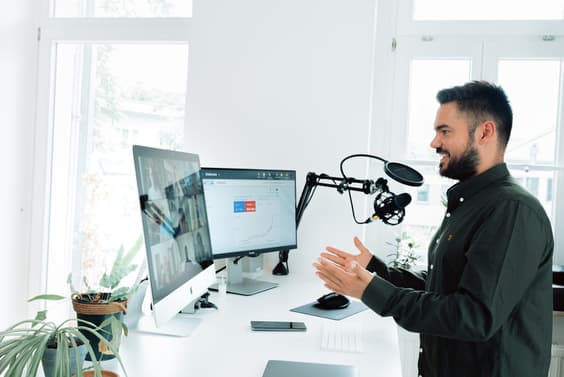Some people organize live sessions. Others create 100% pre-recorded content. And then, some offer blended learning, with both synchronous and asynchronous lessons.
But what works best?
This is where it gets complicated. It depends on your training goal, the nature of your expertise, and your students’ needs.
Let's dig together into the difference between synchronous and asynchronous training to demystify these two teaching methods.
In this article, you will find advice for choosing the best teaching method and 6 tips for creating the best training content!
To help us, we interviewed Mélissa Lapierre and Nicolas Harton, the founders of Communication futée.
Actors, trainers, speakers and authors, they are also speech and video trainers. They have trained and supported more than 4,000 people during conferences, online courses, practical workshops and personalized support sessions in public speaking.
And that's precisely why we wanted to talk to them!
We, therefore, invited them to talk about their experience. Mélissa and Nicolas told us about their transition from face-to-face to digital training and shared some tips for creating quality educational content.
Exclusive online summit
·
May 23 2024
Moments that matter: how to seed great work
What's in this article
What is synchronous training?
Synchronous courses are given live, either in person or through technology. You and your learners must both be available at the session’s scheduled date and time.
It’s a teaching method that focuses on interaction with participants.
For Mélissa and Nicolas from Communication Futée, synchronous training is a SERVICE they offer in response to a DEMAND for a specific need. This could be, for example, corporate training for the sales team.
3 tips for creating synchronous content
- Keep it short. If you run live lessons that last several hours, your learners will lose focus. It’s better to divide your training over different sessions than to try to do it all at once.
- Encourage participation. Since you have your students simultaneously, you might as well take the opportunity to involve them in your course! Invite them to share their experience, ask questions and put into practice what you have presented.
- Personalize the experience. You want to prepare a training that allows time to get to know your audience better. You will be able to adapt your content and your vocabulary according to the learning needs of those present.

What is asynchronous training?
Asynchronous courses are usually pre-recorded, and the content is available to students on a deferred basis. So you need to prepare your lessons and exercises in advance and make them available to your learners at a time that suits them best.
It is a teaching method that promotes the autonomy of participants in their learning process.
For Mélissa and Nicolas, asynchronous courses are PRODUCTS that they can distribute to several people or companies. They, therefore, build an INVENTORY of products, which they can sell separately or in packages.
3 tips for creating asynchronous content
- Test your content. As you have to create all your material upstream, ask some learners to evaluate your online course. You will then receive feedback to improve your content and the learning experience you want to offer.
- Vary the formats. On your training platform, vary the types of content to make your learning program more dynamic! Integrate videos, audio files, PDF documents and texts to stimulate your students.
- Rate your participants. Insert questionnaires at different times in your course to validate the knowledge of your learners. You can confirm if your content is understood and offer support to people who need it.

How to choose between synchronous or asynchronous training?
For a first online course, Communication Futée advises you to start with a synchronous formula. It allows you to test your content, tools, and strategies and better understand your learners’ needs.
But once you've finished your tests, should you continue to offer live sessions?
To help you with this choice, here are some questions that can guide your decision.
- Does your training absolutely require real-time interaction?
- Will your content be as valuable tomorrow as it is today?
- What does your audience prefer?
The important thing is to find the balance that will facilitate the transfer of your expertise to your target audience.
To create a course that your learners will want to complete, you must first build a learning program that meets their needs.

Consider that your point A represents the current situation of your students; their challenges, their pains, their issues.
Point B is the result they want to achieve in connection with your expertise. And you don't have to be afraid to be very specific!
All the steps to go from A to B will become the essential elements of your course. Your role is to present these concepts in a format that will optimize their learning.
The choice of your teaching method must support this objective quite simply.
Blended learning: balance between synchronous and asynchronous
Why choose when you can have it all?
Get the best of both worlds by offering blended learning!
Several training platforms such as Workleap LMS offer the possibility to add synchronous and asynchronous lessons in the same syllabus.
This is an opportunity to take advantage of both teaching methods and provide a complete experience for your learners.
On the Communication Futée’s side, blended learning is mainly used for their coaching program.
Asynchronous contents present all the theoretical portions of the course. Mélissa and Nicolas prepared pre-recorded videos and documents to teach their strategies, methods and techniques.
Synchronous contents become relevant to enhance the learning experience. During live sessions, they can follow up on the topics covered in the theoretical portion, answer questions and guide participants in more specific contexts.

Blended learning has therefore increased the perceived value of their training program significantly!
Let’s try it out!
Now that we’ve covered a few tips to choose your teaching method and create better training content, why not give it a try?
It takes less than a day to set up your platform and upload your training content. So what are you waiting for?
To follow Mélissa and Nicolas, visit their website!
Discover, manage, and grow your team’s skills to unleash their potential and retain your rising stars.




